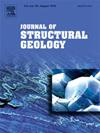随流而动——涡度变化控制太古代剪切带金富集(加拿大苏利尔省舍班道湾绿岩带)
IF 2.9
2区 地球科学
Q2 GEOSCIENCES, MULTIDISCIPLINARY
引用次数: 0
摘要
太古宙造山带金矿一般赋存于脆性-韧性剪切带中,由于物理化学条件的变化,金在该区局部被再活化和再沉淀。然而,在上克拉通太古宙的岩石中,这些剪切带往往是稀疏暴露的,主要是通过空间对比推断出来的,因此对这些剪切带的构造仍然知之甚少。本文应用地质年代学、运动学分析和涡度分析技术,对加拿大安大略省北部的舍班多万绿岩带进行了研究。锆石U-Pb CA-ID-TIMS测年和辉钼矿Re-Os NTIMS测年结果显示,近端长英质侵入岩体年龄为2717.35±0.48 Ma,含金脉成矿年龄为2708±12 Ma,含辉钼矿脉成矿年龄为2708±12 Ma。野外观测和区域年龄资料表明,成矿和侵入活动早于变形。韧性片理走向空间插值表明,金矿成矿在空间上与剪切带走向突变有关。涡度分析-包括刚性卟啉碎屑和晶体涡度分析-表明这些变化引起释放和抑制弯曲的应变分配。这些在剪切带走向中观测到的局部偏转是由于古老的、富长石的、各向同性的、正长岩体(流变学较强)与含金的、中间变质火山和闪长岩单元(流变学较弱)之间的能力对比。从非同轴流主导区域到同轴流主导区域的过渡似乎具有局部流体路径,允许流体在变形过程中迁移和金沉淀。定量分析刚性地质体附近剪切带的挠度,结合变形流型分析,是花岗岩-绿岩带找金的有效手段。本文章由计算机程序翻译,如有差异,请以英文原文为准。

Going with the flow — Changes of vorticity control gold enrichment in Archean shear zones (Shebandowan Greenstone Belt, Superior Province, Canada)
Archean orogenic gold deposits are commonly hosted in brittle-ductile shear zones, where gold is locally remobilized and reprecipitated due to changes in physio-chemical conditions. However, in Archean rocks of the Superior Craton, these shear zones are often sparsely exposed and inferred primarily through spatial correlation, hence these shear zone architectures remain poorly understood. Here, we apply geochronology, kinematic analysis, and vorticity analysis techniques to study the Shebandowan Greenstone Belt in Northern Ontario, Canada. Geochronological results from zircon U-Pb CA-ID-TIMS and molybdenite Re-Os NTIMS dating yielded an age of 2717.35 ± 0.48 Ma for a proximal felsic intrusion and 2708 ± 12 Ma for auriferous and molybdenite-bearing vein mineralization, respectively. Field observations and regional age data indicate that both mineralization and intrusive activity predate deformation. Spatial interpolation of ductile foliation orientations reveals that gold mineralization is spatially associated with abrupt changes in shear zone orientation. Vorticity analysis — including rigid porphyroclast and crystallographic vorticity analysis — shows that these changes induce strain partitioning in releasing and restraining bends. These observed localized deflections in shear zone strike are attributed to the competency contrast between the old, feldspar-rich, isotropic, and syenitic plutonic bodies (rheologically stronger) and gold-bearing, intermediate metavolcanic and diorite units (rheologically weaker). Transitions from non-coaxial to coaxial flow dominated areas appear to have localized fluid pathways, allowing for fluid migration and gold precipitation during deformation. Quantifying deflections of shear zones adjacent to rigid geological bodies, combined with analyzing the deformation flow types, represents a powerful and cost-effective tool for gold exploration in granite-greenstone belts.
求助全文
通过发布文献求助,成功后即可免费获取论文全文。
去求助
来源期刊

Journal of Structural Geology
地学-地球科学综合
CiteScore
6.00
自引率
19.40%
发文量
192
审稿时长
15.7 weeks
期刊介绍:
The Journal of Structural Geology publishes process-oriented investigations about structural geology using appropriate combinations of analog and digital field data, seismic reflection data, satellite-derived data, geometric analysis, kinematic analysis, laboratory experiments, computer visualizations, and analogue or numerical modelling on all scales. Contributions are encouraged to draw perspectives from rheology, rock mechanics, geophysics,metamorphism, sedimentology, petroleum geology, economic geology, geodynamics, planetary geology, tectonics and neotectonics to provide a more powerful understanding of deformation processes and systems. Given the visual nature of the discipline, supplementary materials that portray the data and analysis in 3-D or quasi 3-D manners, including the use of videos, and/or graphical abstracts can significantly strengthen the impact of contributions.
 求助内容:
求助内容: 应助结果提醒方式:
应助结果提醒方式:


